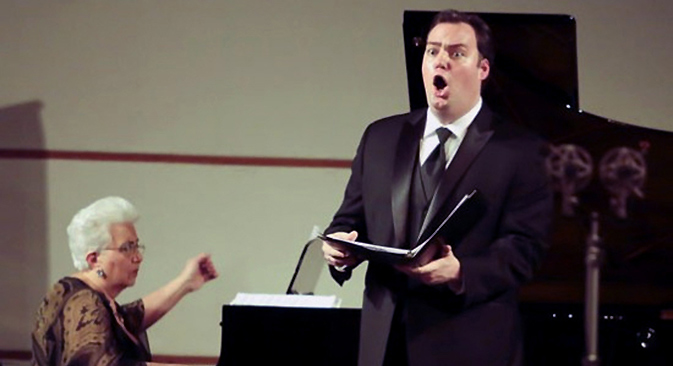Balalaika ensemble enchants D.C.

The group now has a membership of 55 volunteer musicians from 12 to 92 years old.
Press PhotoThe sound of the balalaika is evocative, mysterious and deeply expressive of Russia’s vast cultural history. Originally a peasant’s instrument, the balalaika transcended its roots to become the iconic star of the Russian stage.
In 1988, the Washington Balalaika Society was founded to bring traditional Russian music to the greater Washington D.C. area. It is one of the most active balalaika ensembles worldwide, and has shared Russian culture through music for more than 25 years.
Assistant Conductor Maxwell McCullough, 78, started the ensemble with his wife and a close friend to bring the lyrical sound of the triangular, three-stringed balalaika to American audiences. When McCullough moved from Houston, where he had played with the Houston Balalaika Society, he was surprised that there was no Russian folk orchestra in D.C. He soon found a dozen people who played the balalaika or the domra – an instrument from the Caucasus resembling a lyre – in local ensembles.
“We started a series of weekly ‘jam sessions’ in the basement of our house,” said McCullough. “After four months of practice we performed in the lobby of the Kennedy Center, and the exposure allowed us to perform elsewhere.”
The group continued to expand over the years, growing to its current membership of 55 volunteer musicians 12 to 92 years old. Most of the musicians are Americans, and all have an interesting story to tell about discovering Russian music.
Musician and retired teacher Janet Bohm bought a balalaika when she visited Leningrad (now St. Petersburg) in the 1960s, but struggled to find a teacher until she discovered the Washington Balalaika Society (WBS) in 1993.
“The music is incomparable,” said Bohm. “It has soul and spirit not found anywhere else. Working with Russian musicians differs from working with Americans: I see the desire to bring understanding and perfection to every note and musical phrase.”
The WBS has performed nationally and internationally and produced seven CDs. The group performed at Carnegie Hall in celebration of the 750th anniversary of the founding of Moscow in 1998, and has gone on five musical tours of Russia and Ukraine.
“As far as we are aware,” said McCullough, “we are the largest Russian folk instrument orchestra outside the former U.S.S.R., with more than 15 concerts a year.”
One retired professional musician in the WBS said that Conductor Svetlana Nikonova holds him “to the highest standards I have ever been asked to reach. This gives us all a challenge and a sense of satisfaction when we can say that each performance is better than the last.”
Nikonova is currently in her thirteenth season with the with the orchestra. Born in St. Petersburg, she studied at the Rimsky-Korsakov Conservatory before coming to the U.S. Her thoughtful, intelligent direction creates a meaningful experience for the audience.
The WBS blends familiar and new music to educate Americans about Russian culture. “Nineteenth-century Russian music was very inspired by Russian culture and history,” McCullough said. “It brings with it the opportunity for American audiences to appreciate and understand Russian history, its successes and sorrows, and the sheer breadth of the Russian experience.”
McCullough also uses breaks between songs to weave in stories providing a deeper understanding of the performance. “Don’t Sing Those Songs” (“Ne poi krasavitsa”) combines the talents of two of Russia’s greatest artists, Rachmaninoff and lyrics by Alexander Pushkin: “Alas, your cruel melodies bring back memories of the steppe, the moonlight and the face of a poor, far away maiden. Hearing you sing, I imagine it all again before me,” sang soprano Olga Orlovskaya, accompanied by the orchestra’s 228 strings in their most recent performance.
The Washington Balalaika Society Orchestra performs at the Kenmore Performing Arts Center, Kenmore Middle School, Arlington, Virginia. Source: Youtube
Each performance features renowned guest vocalists and balalaika, domra and bayan artists. The group performs to audiences of hundreds, equal parts Russian and American, and the performers wear traditional costumes.
The ensemble held its most recent concerts Nov. 21 and 22, performing selections from “The Snowstorm” by Georgii Sviridov and five pieces from Tchaikovsky’s “The Nutcracker.” While few Americans are familiar with “The Snowstorm,” everyone recognized “I Could Have Danced” from “My Fair Lady” and pieces from “The Nutcracker.”
The WBS looks forward to its 2016 season.
“It has been our pleasure to work with some of Russia’s greatest artists, and most gratifying to me is the reinforcement of my strong belief that art and culture transcend politics,” said McCullough.
Another musician added: “This group has a feel of family and genuine caring. I am thankful to everyone for adding so much richness to my life, even more than I could have believed it to be when I first started playing with them.”
Origins of the balalaika
This three-stringed musical instrument has a triangular body and a long past. The first known document mentioning the instrument dates back to 1688, which mentions that a citizen and peasant were drunk and playing the balalaika near the Yayza gates in Moscow.
The balalaika was popular as a village instrument for centuries, particularly with herdsmen and traveling musical jesters. The exact origins of the balalaika are unknown; however, it is commonly agreed that it descended from the dombra, an instrument from Asia. In the 1880s, Vasily Andreyev, then a professional violinist in the music salons of St. Petersburg, developed what became the standardized balalaika.
Read more: Past meets present in Russian folk tunes>>>
All rights reserved by Rossiyskaya Gazeta.
Subscribe
to our newsletter!
Get the week's best stories straight to your inbox

